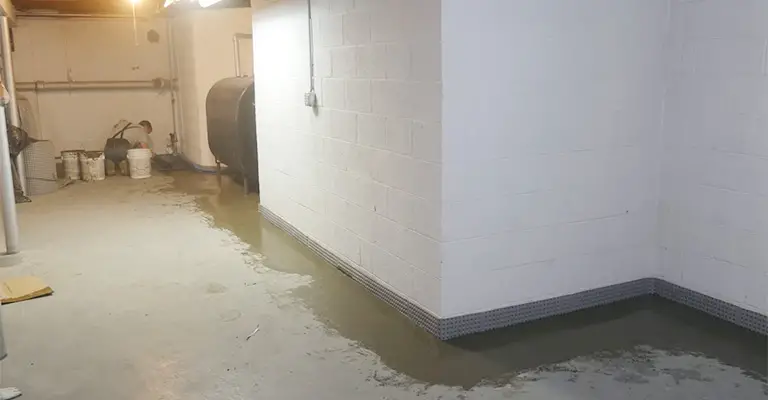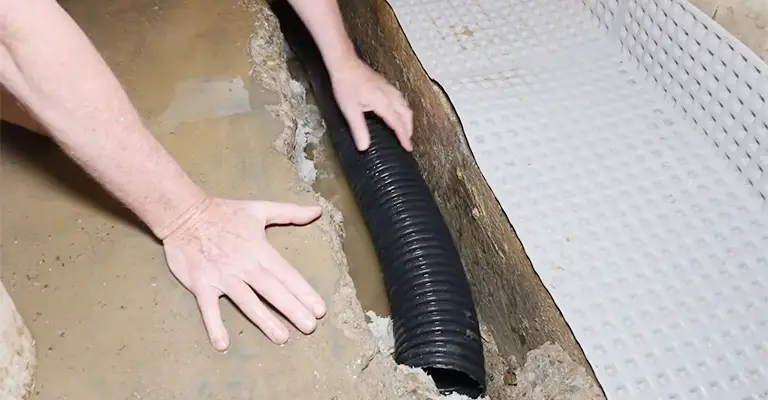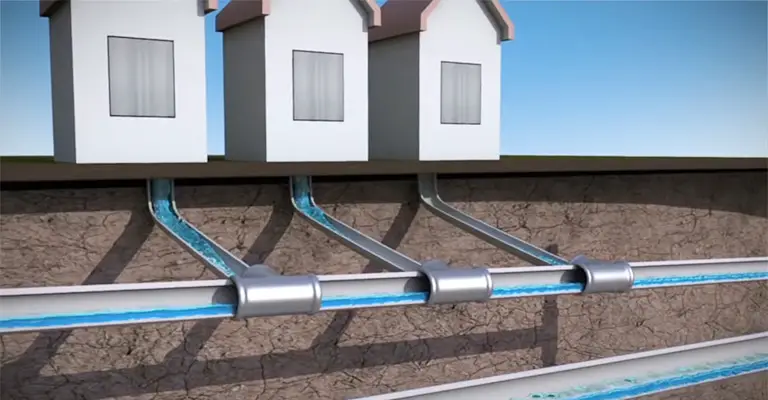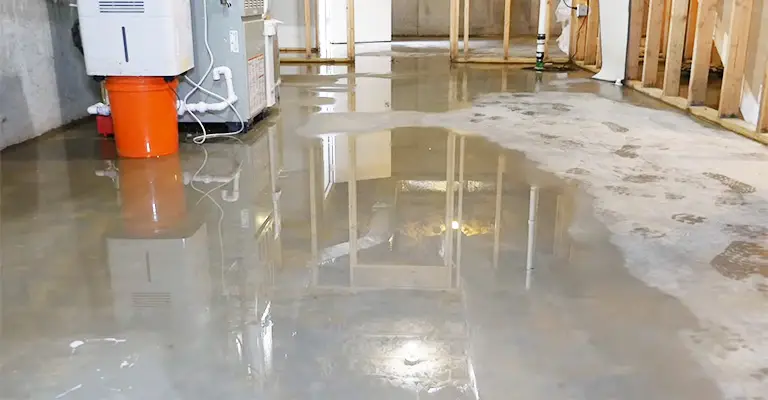When there’s a big rainstorm, it can be suitable for dry areas, but for people with houses, it can be a problem.
Sometimes, after a heavy rain, you might see water coming up through your basement floor drain. This isn’t a good thing, and it can cause damage to your home.
Most often, water backing up from the municipal sanitary sewer system causes water to drain through floor drains or sink drains in the basement.
In times of heavy rain, combined sewers may become overwhelmed with water. Sewer water can back up in the system and reach homes in this manner.
When your basement floods, you shouldn’t go inside until you’re sure the electricity has been disconnected because of the electrocution risk.
You should determine whether water problems are recurring or if it’s a one-time occurrence when your basement floods for the first time.
You need to begin making decisions if water is a consistent issue in your basement. Determining where the water is coming from is essential to fix this problem.
Stop Water From Coming Through Basement Floor Drain With These Steps

Homeowners have a few ways to protect their property from sewer surcharge damage. Listed below are a few recommendations.
1. Sump Pump
Almost every neighborhood has a sump pump. A small piece of equipment, about 2 feet tall and about the same width, they work electronically.
It is usually installed in basements and crawlspaces – wherever the lowest parts of the home are. These pumps are used to remove excess water from a system.
When water starts flowing down your basement drain, it eventually reaches the sump pump.
When the pump detects water underneath the floor surface, it starts working. Once the water spills into the pit, the sump pump is triggered to turn on and re-direct the water away from the building.
2. Stand Pipe
The standpipe is essentially a large pipe installed in the ground that leads any excess water away from the home. Consider it like a sump pump for the basement.
A sump pump essentially adds another drain to your basement or crawlspace. Your plumber can provide you with more information about the advantages and disadvantages of this option.
3. Seal All Foundation Cracks
Cracks in the foundation are the most common reason for basement water intrusion. Fortunately, repairing them is relatively simple. Prevent water intrusion by filling foundation cracks with epoxy sealer.
Furthermore, reinforced wall liners can be added to protect your insulation and drywall from future water damage.
4. Automatic Backwater Valve
This option has many advantages and disadvantages, but it may be the right one for you. It is generally installed on the main sewer line by your house as a check valve. If water starts flowing backwards into the sewer line, the valve closes.
Unfortunately, this option means no one in the house can use the facilities when this valve is closed. In other words, you may have a messy, serious sewer backup.
As a result, your plumber may be able to offer you this option.
Why Is My Basement Drain Backing Up When It Rains?

Water and sewage from each home in each community are managed by sewer systems worldwide. Therefore, all homes in the community are eventually connected to a main sewer line.
During rainstorms, sewer systems run at 100% capacity, so the system can become overwhelmed if the water level is excessive.
Insufficient systems are in place to evacuate such a large volume of water, so excess water spills back into homes. A sewer surcharge can damage your property and is called a “sewer surcharge”.
There Are Two Basic Types Of Drain Systems For Wet Basements
Perimeter above-slab gutter system: Attached to the exterior foundation walls above the floor slab, it drains rainwater from the outer building. In addition to serving as a wall base, it is also a material for ceilings.
Below-slab perimeter drainage system: This system requires partial removal of concrete flooring and drainage pipe installation, making it more expensive.
Underfloor drainage is believed to be better since it relieves hydrostatic pressure before the water reaches the slab’s bottom.
Clog In The Municipal Or Home Sanitary Sewer Line
There may be several causes of sewer backups, such as grease, waste, tree roots, breaks in pipes, or saturated soil. Additionally, large items can be dropped down manholes or vandalized to obstruct main sewer lines.
In addition to being out of your control, this type of flooding can be dangerous to the health of your home because it can result in feet backing up into basements and posing a severe health risk.
Installing backflow preventers is possible to prevent sewer water from flowing backwards into your home.
In addition to proper maintenance, pouring tree root killer down your toilets once a year can also contribute to preventing sewage backups. Even so, many problems are beyond your control.
You’re faced with a lot of cleaning and uncertainty when you discover sewage in your basement.
Involving your city government is essential if you’ve noticed something in your home. Do not leave anything valuable near your downstairs drains, or be aware of the problem.
Backup Of Storm Sewer Water From The Municipal Storm Sewer System

Many older homes with basements (mainly pre-1980) have perimeter foundation drains next to the footings at the basement floor level.
Storm sewer pipes were usually installed from the perimeter foundation drain to the street for connection to the city.
It can become a problem when the city storm sewer system becomes too small due to more excellent development. Consequently, the rainwater in a sewer system can overflow, causing the water to flow backwards and into the house.
Installing a perimeter basement drain system with a sump pump often solves the issue.
A (more expensive) alternative would be to dig up and cap the pipe exiting from the perimeter foundation drain to the street.
Sometimes, however, this is impossible; the pipes also drain sanitary waste from toilets and sinks. You should consult an experienced contractor if you think this problem exists.
Surface Water Leaking Into Basement
You should first check for surface water draining down against the foundation walls if this is the first instance of water problems in your basement.
Surface water problems can be detected by water coming in at only one location or one place along the exterior foundation wall. The following things should be on your radar once you’re outside.
Landscape Slope
The land surrounding your home slopes away from it. Yes, it should. Be sure to look for any depressions in the ground around the foundation walls. It is best to fill any holes found with dirt so that the water drains away from the house.
The best soil to use is clay, which sheds water instead of sandy soil, which enables water to absorb. Maintain a minimum of eight inches of space between the top of the earth and any wood or stucco on the house.
The situation may require the services of a civil engineer if there are significant hills nearby sloping toward your home so that he or she can analyze the situation and determine the best possible solution.
Over time, sealants around pavement that borders the house can crack due to age or incorrect installation. Replacement of cracked sealants is required if the sealant is cracked.
Pavement Slope:
In some situations, paving settles over time, causing the direction of the water flow to change toward the house. As a result, the paving should be removed and replaced so that it slopes away from the home.
Downspout Distance:
You should keep your downspouts at least 10 feet away from your home. The minimum distance necessary to discharge water coming off your roof far enough away from the house is 10 feet. Many homeowners dislike downspouts extending this far out, but this is the minimum distance needed to convey water from your roof.
Overflowing Gutters — Downspouts:
If you don’t mind getting wet, you can do a self-check (before completing the self-check, ensure your gutters are clean). Ensure your gutters have been cleaned after at least 15 minutes of heavy rain.
There may be a problem if you see any overflowing water. Overflowing gutters run down to the house foundation, where rainwater gathers.
A leak in the basement could lead to eroding soil from the foundation, leading to cracks in the walls and ceilings.
Overflowing Gutters — Leaves:
Cleaning gutters of debris is part of routine maintenance for every homeowner.
It may be necessary to clean the gutters several times a year, depending on the surrounding trees. In addition, there are products on the market that keep leaves from getting into gutters.
Location Of The Drain System
You may need to install one if you live in an older townhouse with a basement but no sump pump. If that is the case, the perimeter foundation drains may connect directly with the city storm sewer system.
When the basement level is below the street level, storm water can be backing up into the city storm sewer system and being pushed into the perimeter foundation drain.
Water may leak into the basement from the soil beneath due to hydrostatic pressure, which saturates the soil at the basement level.
The best method of controlling subsurface groundwater is to install some type of perimeter drain system to relieve hydrostatic pressure, regardless of where it comes from.
A groundwater pump pushes the water to the drain system, not to carpets, walls, or belongings. During rainy weather, water drains by gravity into a sump pit, where a sump pump discharges it.
Who Covers The Cost Of Basement Flooding Due To Heavy Rain?
If pipes burst or other issues cause the basement to flood, most homeowners’ policies are going to cover it.
In some cases, however, damage that occurs because of improper maintenance may not be covered. Generally, you need separate insurance to cover natural disasters, underground seepage, and sewer backups.
Final Words
There is a possibility of sewage backwash into homes during heavy rains, so homeowners should be aware of this possibility and take precautions to avoid damaging their homes.
Ensure your gutters are cleaned and maintained twice a year – once in the spring and once in the fall.
Replace any gutters with holes or worn-out joints if they need to be repaired. Downspout extenders help divert rainwater away from your home’s foundation and away from your downspouts.








